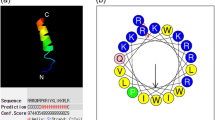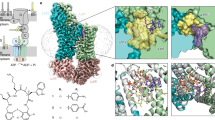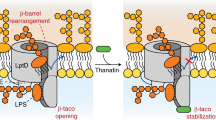Abstract
Lipopolysaccharide (LPS) is a strong endotoxin and is delivered to the cell surface signaling receptor, Toll-like receptor 4 and MD-2 complex, via soluble cluster of differentiation (CD) 14 or membranous CD14, resulting in the induction of the inflammatory response. To obtain new compounds that block LPS binding to CD14, we designed a high-throughput screening based on time-resolved intermolecular fluorescence resonance energy transfer. This cell-free screening system successfully led to the discovery of novel inhibitors of LPS-CD14 interaction from the library of the secondary metabolites of microorganisms. We identified the novel compounds pedopeptin A, B and C from a culture broth of Pedobacter sp. SANK 72003. Pedopeptins blocked LPS binding to CD14 in vitro with IC50 values of 20, 11 and 47 nM, respectively, and also inhibited LPS binding to the cells expressing CD14, leading to the suppression of cytokine production. Moreover, they showed antimicrobial activities against Escherichia coli with minimum inhibitory concentration ranging from 2 to 4 μg ml−1.
Similar content being viewed by others
Log in or create a free account to read this content
Gain free access to this article, as well as selected content from this journal and more on nature.com
or
References
Hailman, E. et al. Lipopolysaccharide (LPS)-binding protein accelerates the binding of LPS to CD14. J. Exp. Med. 179, 269–277 (1994).
Bazil, V. et al. Biochemical characterization of a soluble form of the 53-kDa monocyte surface antigen. Eur. J. Immunol. 16, 1583–1589 (1986).
Haziot, A. et al. The monocyte differentiation antigen, CD14, is anchored to the cell membrane by a phosphatidylinositol linkage. J. Immunol. 141, 547–552 (1988).
Hoshino, K. et al. Cutting edge: Toll-like receptor 4 (TLR4)-deficient mice are hyporesponsive to lipopolysaccharide: evidence for TLR4 as the Lps gene product. J. Immunol. 162, 3749–3752 (1999).
Shimazu, R. et al. MD-2, a molecule that confers lipopolysaccharide responsiveness on Toll-like receptor 4. J. Exp. Med. 189, 1777–1782 (1999).
Da Silva Correia, J., Soldau, K., Christen, U., Tobias, P. S. & Ulevitch, R. Lipopolysaccharide is in close proximity to each of the proteins in its membrane receptor complex: transfer from CD14 to TLR4 and MD-2. J. Biol. Chem. 276, 21129–21135 (2001).
Beutler, B. & Rietschel, E. T. Innate immune sensing and its roots: the story of endotoxin. Nat. Rev. Immunol. 3, 169–176 (2003).
Wong, Y. N. et al. Continuous pharmacodynamic activity of eritoran tetrasodium, a TLR4 antagonist, during intermittent intravenous infusion into normal volunteers. Innate. Immun. 14, 383–394 (2008).
Stansly, P. G., Shepherd, R. G. & White, H. J. Polymyxin: a new chemotherapeutic agent. Bull. Johns Hopkins Hosp. 81, 43–54 (1947).
Rifkind, D. Prevention by polymyxin B of endotoxin lethality in mice. J. Bacteriol. 93, 1463–1464 (1967).
Jacobs, D. M. & Morrison, D. C. Inhibition of the mitogenic response to lipopolysaccharide (LPS) in mouse spleen cells by polymyxin B. J. Immunol. 118, 21–27 (1977).
From, A. H., Fong, J. S. & Good, R. A. Polymyxin B sulfate modification of bacterial endotoxin: effects on the development of endotoxin shock in dogs. Infect. Immun. 23, 660–664 (1979).
Vinnicombe, J. & Stamey, T. A. The relative nephrotoxicities of polymyxin B sulfate, sodium sulfomethyl-polymyxin B, sodium sulfomethyl-colistin (colymycin), and neomycin sulfate. Invest. Urol. 6, 505–519 (1969).
Mathis, G. Rare earth cryptates and homogeneous fluoroimmunoassays with human sera. Clin. Chem. 39, 1953–1959 (1993).
Hirota-Takahata, Y. et al. Pedopeptins, novel inhibitors of LPS: Taxonomy of producing organism, fermentation, isolation, physicochemical properties and structural elucidation. J. Antibiot. (doi:10.1038/ja.2013.122).
Huber, M. et al. R-form LPS, the master key to the activation of TLR4/MD-2-positive cells. Eur. J. Immunol. 36, 710–711 (2006).
Gangloff, S. C., Hijiya, N., Haziot, A. & Goyert, S. M. Lipopolysaccharide structure influences the macrophage response via CD14-independent and CD14-dependent pathways. Clin. Infect. Dis. 28, 491–496 (1999).
Bryant, C. E. et al. The cellular Toll-like receptor 4 antagonist E5531 can act as an agonist in horse whole blood. Vet. Immunol. Immunopathol. 116, 182–189 (2007).
Zavascki, A. P. et al. Pharmacokinetics of intravenous polymyxin B in critically ill patients. Clin. Infect. Dis. 15, 1298–1304 (2008).
Mingeot-Leclercq, M. P., Tulkens, P. M., Denamur, S., Vaara, T. & Vaara, M. Novel polymyxin derivatives are less cytotoxic than polymyxin B to renal proximal tubular cells. Peptides 35, 248–252 (2012).
Vaara, M., Sader, S. S., Rhomberg, P. R., Jones, R. N. & Vaara, T. Antimicrobial activity of the novel polymyxin derivative NAB739 tested against Gram-negative pathogens. J. Antimicrob. Chemother. 68, 636–639 (2013).
Tamaki, M. et al. Polycationic gramicidin S analogues with both high antibiotic activity and very low hemolytic activity. Chem. Pharm. Bull. 60, 1134–1138 (2012).
Hoess, A., Watson, S., Siber, G. R. & Liddington, R. Crystal structure of an endotoxin-neutralizing protein from the horseshoe crab, Limulus anti-LPS factor, at 1.5Å´ resolution. EMBO J. 12, 3352–3356 (1993).
National Committee for Clinical Laboratory Standards. Methods for dilution antimicrobial susceptibility test for bacteria that grow aerobically, 5th ed., approved standard M7-A5, NCCLS: Wayne, PA, USA, (2000).
Acknowledgements
We would like to thank Ms Naoko Matsui and Dr Takao Ohyama for their support in the assay establishment. We acknowledge Dr Teiji Wada and Dr Fujio Isono for discussions and science review.
Author information
Authors and Affiliations
Corresponding author
Rights and permissions
About this article
Cite this article
Kozuma, S., Hirota-Takahata, Y., Fukuda, D. et al. Screening and biological activities of pedopeptins, novel inhibitors of LPS produced by soil bacteria. J Antibiot 67, 237–242 (2014). https://doi.org/10.1038/ja.2013.121
Received:
Revised:
Accepted:
Published:
Issue date:
DOI: https://doi.org/10.1038/ja.2013.121
Keywords
This article is cited by
-
Nitrogen source as a modulator of the metabolic activity of Pedobacter lusitanus NL19: a transcriptomic approach
Applied Microbiology and Biotechnology (2022)
-
Ogipeptins, novel inhibitors of LPS: physicochemical properties and structural elucidation
The Journal of Antibiotics (2017)
-
Identification and biological activity of ogipeptins, novel LPS inhibitors produced by marine bacterium
The Journal of Antibiotics (2017)
-
Pedopeptins, novel inhibitors of LPS: Taxonomy of producing organism, fermentation, isolation, physicochemical properties and structural elucidation
The Journal of Antibiotics (2014)



